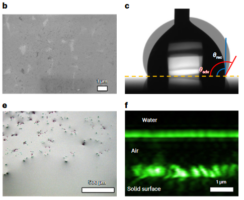Aerophilic surfaces immersed underwater trap films of air known as
plastron. Plastron has typically been considered impractical for
underwater engineering applications due to their metastable performance.
Here, we describe aerophilic titanium alloy (Ti) surfaces with extended
plastron lifetimes that are conserved for months underwater. Long-term
stability is achieved by the formation of highly rough hierarchically
structured surfaces via electrochemical anodization combined with a
low-surface-energy coating produced by a fluorinated surfactant. Aerophilic
Ti surfaces drastically reduce blood adhesion and, when submerged in
water, prevent adhesion of bacteria and marine organisms such as barnacles
and mussels. Overall, we demonstrate a general strategy to achieve the
long-term stability of plastron on aerophilic surfaces for previously
unattainable underwater applications.
Read the full publication in Nature Materials and blogs of FAU and Harvard.


